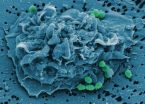(Press-News.org) Researchers at the National Institute of Standards and Technology (NIST) have provided evidence in the laboratory that single-wall carbon nanotubes (SWCNTs) may help protect DNA molecules from damage by oxidation. In nature, oxidation is a common chemical process in which a reactive chemical removes electrons from DNA and may increase the chance for mutations in cells. More studies are needed to see if the in vitro protective effect of nanotubes reported in the laboratory also occurs in vivo, that is, within a living organism.
"Our findings don't tell us whether carbon nanotubes are good or bad for people and the environment," says Elijah Petersen, one of the authors of the study. "However, the results do help us better understand the mechanisms by which nanotubes might interact with biomolecules."
Single-wall carbon nanotubes—tiny hollow rods that are one-atom-thick sheets of graphene rolled into cylinders 10,000 times smaller in diameter than a human hair—are prized for their extraordinary optical, mechanical, thermal and electronic properties. They are being used to produce lightweight and extremely strong materials, enhance the capabilities of devices such as sensors, and provide a novel means of delivering drugs with great specificity. However, as carbon nanotubes become increasingly incorporated into consumer and medical products, the public concern about their potential environmental, health and safety (EHS) risks has grown. Scientifically determining the level of risk associated with the carbon nanotubes has been challenging, with different studies showing conflicting results on cellular toxicity. One of the components lacking in these studies is an understanding of what physically happens at the molecular level.
In a recent paper,* NIST researchers investigated the impact of ultrasonication on a solution of DNA fragments known as oligomers in the presence and absence of carbon nanotubes. Ultrasonication is a standard laboratory technique that uses high-frequency sound waves to mix solutions, break open cells or process slurries. The process can break water molecules into highly reactive agents such as hydroxyl radicals and hydrogen peroxide that are similar to the oxidative chemicals that commonly threaten mammalian cell DNA, although the experimental levels from sonication are much greater than those found naturally within cells. "In our experiment, we were looking to see if the nanotubes enhanced or deterred oxidative damage to DNA," Petersen says.
Contrary to the expectation that carbon nanotubes will damage biomolecules they contact, the researchers found that overall levels of accumulated DNA damage were significantly reduced in the solutions with nanotubes present. "This suggests that the nanotubes may provide a protective effect against oxidative damage to DNA," Petersen says.
A possible explanation for the surprising result, Petersen says, is that the carbon nanotubes may act as scavengers, binding up the oxidative species in solution and preventing them from interacting with DNA. "We also saw a decrease in DNA damage when we did ultrasonication in the presence of dimethyl sulfoxide (DMSO), a chemical compound known to be a hydroxyl radical scavenger," Petersen says.
Petersen says that a third experiment where ultrasonication was performed in the presence of DMSO and SWCNTs at the same time produced an additive effect, reducing the DNA damage levels more significantly than either treatment alone.
INFORMATION:
This research is part of NIST's work to help characterize the potential EHS risks of nanomaterials, and develop methods for identifying and measuring them.
* E.J. Petersen, X. Tu, M. Dizdaroglu, M. Zheng and B.C. Nelson. Protective roles of single-wall carbon nanotubes in ultrasonication-induced DNA base damage. Small (2012), DOI: 10/1002/smll.201201217.
NIST study suggests carbon nanotubes may protect DNA from oxidation
2012-11-15
ELSE PRESS RELEASES FROM THIS DATE:
Chronic fatigue syndrome -- a system under stress
2012-11-15
Australian researchers have discovered for the first time that reduced heart rate variability – or changes in heart beat timing – best predicts cognitive disturbances, such as concentration difficulties commonly reported by people with chronic fatigue syndrome (CFS). This adds to the growing body of evidence linking autonomic nervous system imbalance to symptoms of this poorly understood disorder.
The findings are reported in the journal PLOS ONE.
Chronic fatigue syndrome is characterised by medically unexplained, disabling fatigue and neuropsychiatric symptoms of ...
Flame retardants linked to neurodevelopmental delays in children
2012-11-15
Berkeley — Prenatal and childhood exposure to flame retardant compounds are linked to poorer attention, fine motor coordination and IQ in school-aged children, a finding by researchers at the University of California, Berkeley, that adds to growing health concerns over a chemical prevalent in U.S. households.
The new study, to be published in the Nov. 15 issue of the journal Environmental Health Perspectives, focuses on PBDEs, or polybrominated diphenyl ethers, a class of persistent, endocrine-disrupting compounds widely found in foam furniture, electronics, carpets, ...
At least one-third of marine species remain undescribed
2012-11-15
At least one-third of the species that inhabit the world's oceans may remain completely unknown to science. That's despite the fact that more species have been described in the last decade than in any previous one, according to a report published online on November 15 in the Cell Press publication Current Biology that details the first comprehensive register of marine species of the world—a massive collaborative undertaking by hundreds of experts around the globe.
The researchers estimate that the ocean may be home to as many as one million species in all—likely not more. ...
Surprising genetic link between kidney defects and neurodevelopmental disorders in kids
2012-11-15
New York, NY (November 15, 2012) — About 10 percent of kids born with kidney defects have large alterations in their genomes known to be linked with neurodevelopmental delay and mental illness, a new study by Columbia University Medical Center (CUMC) researchers has shown.
The study was published today in the online edition of the American Journal of Human Genetics.
Congenital defects of the kidney and urinary tract account for nearly 25 percent of all birth defects in the US and are present in about 1 in every 200 births. Eventually, an evaluation for genomic alterations ...
Appetite suppressant for scavenger cells
2012-11-15
This press release is available in German.
When infected with influenza, the body becomes an easy target for bacteria. The flu virus alters the host's immune system and compromises its capacity to effectively fight off bacterial infections. Now, a team of immunologists at the Helmholtz Centre for Infection Research (HZI) and cooperation partners has discovered that an immune system molecule called TLR7 is partly to blame. The molecule recognizes the viral genome – and then signals scavenger cells of the immune system to ingest fewer bacteria. The researchers published ...
This is your brain on freestyle rap
2012-11-15
Researchers in the voice, speech, and language branch of the National Institute on Deafness and Other Communication Disorders (NIDCD) at the National Institutes of Health (NIH) have used functional magnetic resonance imaging to study the brain activity of rappers when they are "freestyling" – spontaneously improvising lyrics in real time. The findings, published online in the November 15 issue of the journal Scientific Reports, reveal that this form of vocal improvisation is associated with a unique functional reallocation of brain activity in the prefrontal cortex and ...
About one million species inhabit the ocean
2012-11-15
Every taxonomist has calculated the number of existing species within their specialty and estimated the number that remain to be discovered, both through statistical models as based on the experience of each expert. According to Enrique Macpherson, researcher at the Center for Advanced Studies of Blanes (CEAB-CSIC, Spain), who has participated in the study: "Bringing together the leading taxonomists around the world to pool their information has been the great merit of this research".
The statistical prediction is based on the rate of description for new species in recent ...
Penn study decodes molecular mechanisms underlying stem cell reprogramming
2012-11-15
PHILADELPHIA – Fifty years ago, British researcher John Gurdon demonstrated that genetic material from non-reproductive, or somatic, cells could be reprogrammed into an embryonic state when transferred into an egg. In 2006, Kyoto University researcher Shinya Yamanaka expanded on those findings by expressing four proteins in mouse somatic cells to rewind their genetic clocks, converting them into embryonic-like stem cells called induced pluripotent stem cells, or iPS cells.
In early October, Gurdon and Yamanaka were awarded the 2012 Nobel Prize in Physiology or Medicine ...
Early 50s may be key time to reach baby boomers with health messages
2012-11-15
COLUMBUS, Ohio -- For baby boomers, the peak interest in health issues comes at about age 51, with a second peak coming near age 65, according to a new study.
The results may help doctors and other professionals target this generation with health messages at a time when they are most receptive to hearing them, the researchers said.
The study, based on a survey of Americans age 45 to 65, showed that people in their late 40s had the lowest levels of interest in health issues. Interest rose quickly, however, and peaked in the early 50s, then dropped slightly and plateaued ...
Feinstein Institute researchers discover plant derivative
2012-11-15
MANHASSET, NY – Researchers at The Feinstein Institute for Medical Research have discovered that tanshinones, which come from the plant Danshen and are highly valued in Chinese traditional medicine, protect against the life-threatening condition sepsis. The findings are published in the December issue of Biochemical Pharmacology.
Inflammation is necessary for maintaining good health – without inflammation, wounds and infections would never heal. However, persistent and constant inflammation can damage tissue and organs, and lead to diseases such as sepsis. Sepsis affects ...



